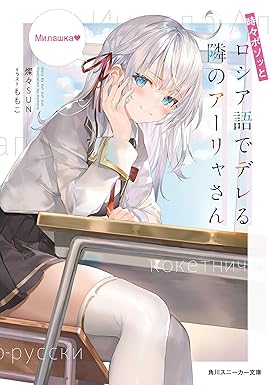Recently, an illustration of a character from the light novel When the Neighboring Arya Sometimes Softly Murmurs in Russian (Tokidoki Bosotto Roshiago de Dereru Tonari no Arya-san) posted on a Kyoto City Subway Karasuma Line train has been criticized as “too sexual,” sparking discussions on social media and in some media outlets. Arya is a romantic comedy series in which the cool Russian beauty Arya, a classmate, gradually opens her heart to others, occasionally switching to Russian as she does so. In this particular advertisement, a large illustration of Arya in a “moe” style was placed near the train doors, and her portrayal has been deemed “inappropriate” by some commuters.
Using characters from anime and light novels in advertisements is a common marketing strategy in Japan, especially targeted toward younger audiences and anime fans. However, the design and portrayal of these characters sometimes draw criticism for being “too sexual.” This case has become another example of such controversy.
Details of the Advertisement
The advertisement in question was displayed on the Kyoto City Subway Karasuma Line, prominently near the doors where passengers board and exit the train. The illustration featured Arya in her school uniform, depicted in a “moe” style as she made a hair-flipping gesture. While Arya is simply shown in her school uniform, her pose and expression were enough to spark criticism from some passengers, who considered the ad to be “too sexual.”
Many criticisms focused on the fact that this kind of “moe” character depiction was prominently displayed in a public space used by families and children. While the creators of the ad likely intended to reflect the character’s personality and the world of the novel, they have yet to issue an official statement regarding the controversy.
Nature of the Criticism
Much of the criticism, especially on social media, revolves around the idea that “this kind of imagery is inappropriate in a public space.” Many argue that a public space like a subway train, which is used by families and children, should not feature this type of “moe” art. Others expressed concerns that the female character’s gesture was overly sexualized and that it reinforced the objectification of women, raising broader gender-related issues.
Some critics also directed their frustration at Kyoto City, questioning the decision to allow such an advertisement on the subway system. The debate has now expanded to include the responsibilities of both the advertising company and public transportation operators.
Past Cases of Criticism of Anime Characters
This is not the first time anime or “moe” characters have been criticized for being overly sexual. For example, in 2015, a poster campaign at Kashiwa-no-ha Campus Station in Chiba Prefecture featuring a female anime character was criticized for being too revealing for a public setting. The poster was quickly removed following public outcry.
In 2020, a tourism campaign in Okinawa using characters from the popular anime Love Live! also faced criticism when the characters were shown in swimsuits, which was deemed inappropriate for the image of the destination. As a result, the design of the poster was changed.
These cases show that anime and “moe” character designs are frequently considered too sexual for public spaces, often leading to calls for their removal or redesign.
Reactions Online and Public Opinion
Online, there has been a mix of support for and opposition to the criticism. Many people on social media have voiced concerns that the reaction is overblown, with comments like “Isn’t this too much of an overreaction?” and “Why are people so sensitive about anime characters?” Anime fans, in particular, have defended the ad, arguing that Arya’s pose is simply in line with her character and does not have any sexual implications.
On the other hand, there are many who believe that the use of “moe” characters in public spaces like a subway can indeed be uncomfortable for non-anime fans. Some argue that placing such characters in areas that everyone must pass through can create a sense of unease for those unfamiliar with or opposed to anime culture.
The Role of Cultural Perception in Criticizing Anime
Much of the criticism of anime and “moe” culture stems from differences in cultural perception. In Japan, anime and “moe” characters are widely accepted across various age groups, and the stylized portrayals are often seen as innocent or part of a fictional world. However, those unfamiliar with anime or who hold different cultural values may interpret these characters’ gestures and designs as overly sexual.
This particular case might reflect a broader misunderstanding of anime culture, where the character’s design was misinterpreted due to a lack of familiarity with the medium.
Is This an Overreaction?
In my view, the criticism of this advertisement is an overreaction. Arya’s pose and design are consistent with her character’s setting in the light novel, and this should be recognized as part of a fictional universe. Conflating a stylized, fictional character’s expression with real-world sexual implications reflects a misunderstanding of the artistic medium.
While it is important to consider public sensibilities in spaces like a subway, imposing excessive restrictions on creative expression risks stifling cultural diversity and freedom of expression.
Conclusion: Balancing Sensitivity and Freedom of Expression
This controversy highlights the delicate balance between public sensitivity and creative freedom in public spaces. While criticism plays an important role in society, it is also essential not to over-regulate artistic and cultural expressions, which could hinder the growth and diversity of creative industries.
As anime culture is a valuable cultural asset in Japan, a deeper understanding and thoughtful discussion are necessary when considering such debates. Moving forward, finding the right balance between public decency and creative expression will require calm and measured dialogue.









Comments